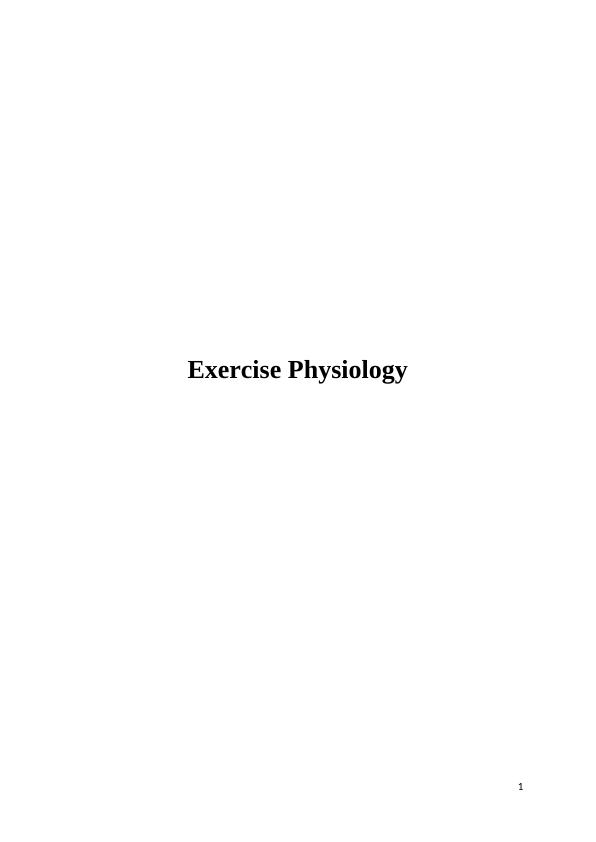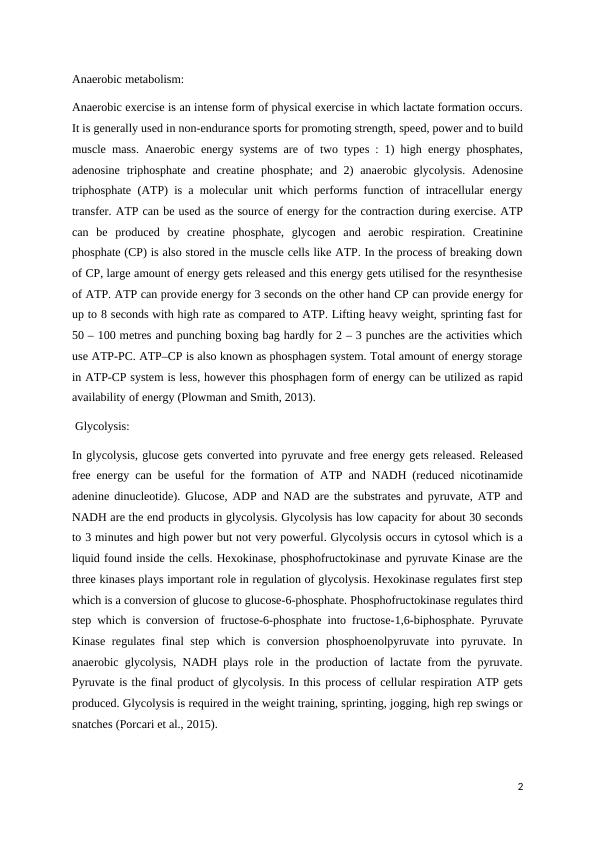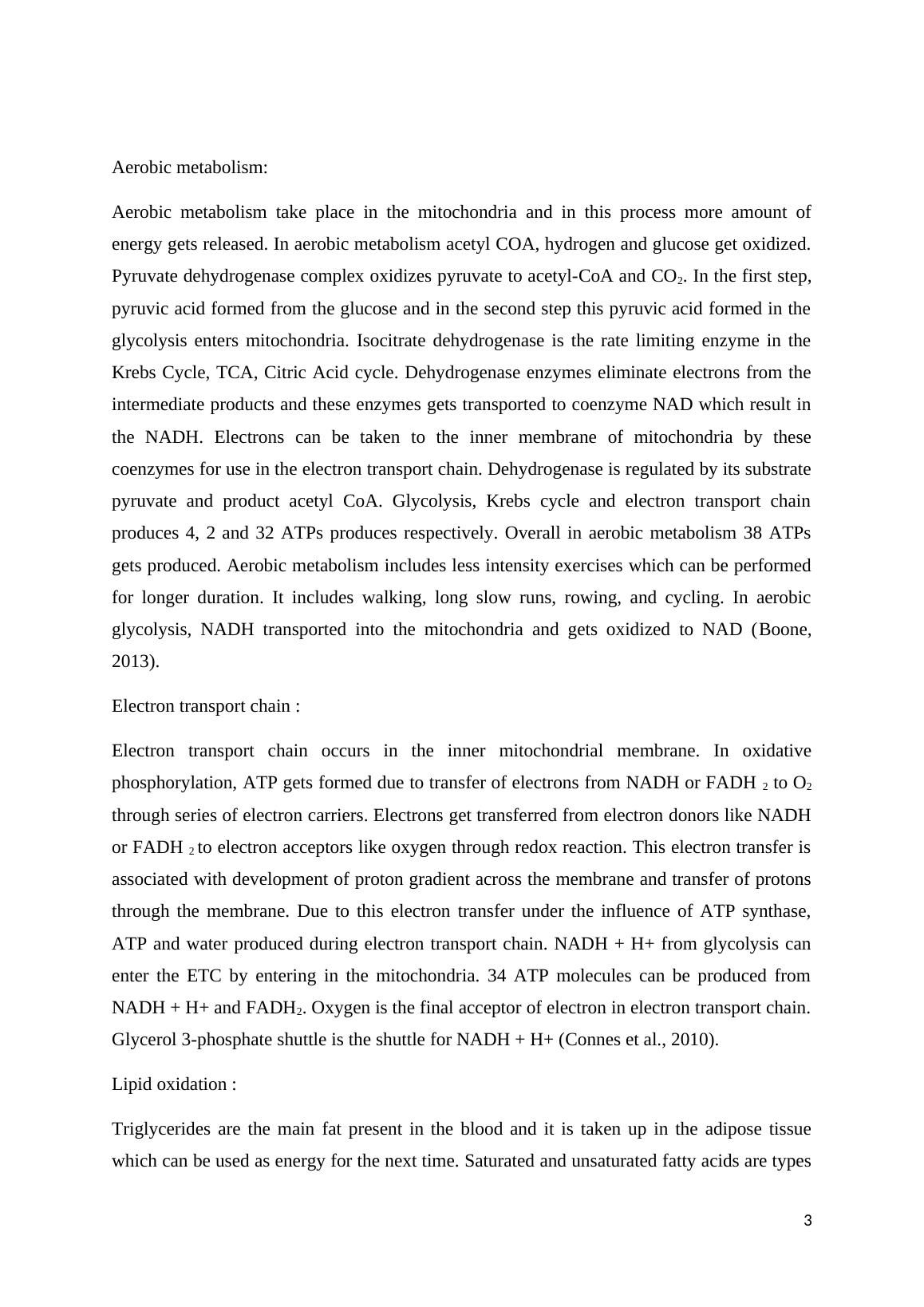Ask a question from expert
Exercise Physiology Assignment
6 Pages1798 Words98 Views
Added on 2021-04-24
Exercise Physiology Assignment
Added on 2021-04-24
BookmarkShareRelated Documents
Exercise Physiology1

Anaerobic metabolism:Anaerobic exercise is an intense form of physical exercise in which lactate formation occurs.It is generally used in non-endurance sports for promoting strength, speed, power and to buildmuscle mass. Anaerobic energy systems are of two types : 1) high energy phosphates,adenosine triphosphate and creatine phosphate; and 2) anaerobic glycolysis. Adenosinetriphosphate (ATP) is a molecular unit which performs function of intracellular energytransfer. ATP can be used as the source of energy for the contraction during exercise. ATPcan be produced by creatine phosphate, glycogen and aerobic respiration. Creatininephosphate (CP) is also stored in the muscle cells like ATP. In the process of breaking downof CP, large amount of energy gets released and this energy gets utilised for the resynthesiseof ATP. ATP can provide energy for 3 seconds on the other hand CP can provide energy forup to 8 seconds with high rate as compared to ATP. Lifting heavy weight, sprinting fast for50 – 100 metres and punching boxing bag hardly for 2 – 3 punches are the activities whichuse ATP-PC. ATP–CP is also known as phosphagen system. Total amount of energy storagein ATP-CP system is less, however this phosphagen form of energy can be utilized as rapidavailability of energy (Plowman and Smith, 2013). Glycolysis:In glycolysis, glucose gets converted into pyruvate and free energy gets released. Releasedfree energy can be useful for the formation of ATP and NADH (reduced nicotinamideadenine dinucleotide). Glucose, ADP and NAD are the substrates and pyruvate, ATP andNADH are the end products in glycolysis. Glycolysis has low capacity for about 30 secondsto 3 minutes and high power but not very powerful. Glycolysis occurs in cytosol which is aliquid found inside the cells. Hexokinase, phosphofructokinase and pyruvate Kinase are thethree kinases plays important role in regulation of glycolysis. Hexokinase regulates first stepwhich is a conversion of glucose to glucose-6-phosphate. Phosphofructokinase regulates thirdstep which is conversion of fructose-6-phosphate into fructose-1,6-biphosphate. PyruvateKinase regulates final step which is conversion phosphoenolpyruvate into pyruvate. Inanaerobic glycolysis, NADH plays role in the production of lactate from the pyruvate.Pyruvate is the final product of glycolysis. In this process of cellular respiration ATP getsproduced. Glycolysis is required in the weight training, sprinting, jogging, high rep swings orsnatches (Porcari et al., 2015).2

Aerobic metabolism:Aerobic metabolism take place in the mitochondria and in this process more amount ofenergy gets released. In aerobic metabolism acetyl COA, hydrogen and glucose get oxidized.Pyruvate dehydrogenase complex oxidizes pyruvate to acetyl-CoA and CO2. In the first step,pyruvic acid formed from the glucose and in the second step this pyruvic acid formed in theglycolysis enters mitochondria. Isocitrate dehydrogenase is the rate limiting enzyme in theKrebs Cycle, TCA, Citric Acid cycle. Dehydrogenase enzymes eliminate electrons from theintermediate products and these enzymes gets transported to coenzyme NAD which result inthe NADH. Electrons can be taken to the inner membrane of mitochondria by thesecoenzymes for use in the electron transport chain. Dehydrogenase is regulated by its substratepyruvate and product acetyl CoA. Glycolysis, Krebs cycle and electron transport chainproduces 4, 2 and 32 ATPs produces respectively. Overall in aerobic metabolism 38 ATPsgets produced. Aerobic metabolism includes less intensity exercises which can be performedfor longer duration. It includes walking, long slow runs, rowing, and cycling. In aerobicglycolysis, NADH transported into the mitochondria and gets oxidized to NAD (Boone,2013).Electron transport chain :Electron transport chain occurs in the inner mitochondrial membrane. In oxidativephosphorylation, ATP gets formed due to transfer of electrons from NADH or FADH 2 to O2through series of electron carriers. Electrons get transferred from electron donors like NADHor FADH 2 to electron acceptors like oxygen through redox reaction. This electron transfer isassociated with development of proton gradient across the membrane and transfer of protonsthrough the membrane. Due to this electron transfer under the influence of ATP synthase,ATP and water produced during electron transport chain. NADH + H+ from glycolysis canenter the ETC by entering in the mitochondria. 34 ATP molecules can be produced fromNADH + H+ and FADH2. Oxygen is the final acceptor of electron in electron transport chain.Glycerol 3-phosphate shuttle is the shuttle for NADH + H+ (Connes et al., 2010). Lipid oxidation :Triglycerides are the main fat present in the blood and it is taken up in the adipose tissuewhich can be used as energy for the next time. Saturated and unsaturated fatty acids are types3

End of preview
Want to access all the pages? Upload your documents or become a member.
Related Documents
Process of Energy Production by Aerobic Respirationlg...
|10
|1727
|293
Energy Processes in Exercise Sciencelg...
|6
|1048
|235
Assign. 1: Question 1 Surname, First Name. a).Glucose mlg...
|4
|2931
|28
Chemistry and Biochemistry – BIOB111lg...
|11
|1544
|260
Endpoints of Toxicity - Assignmentlg...
|20
|5159
|95
The Importance of Exercise in Cancer Managementlg...
|10
|2544
|66